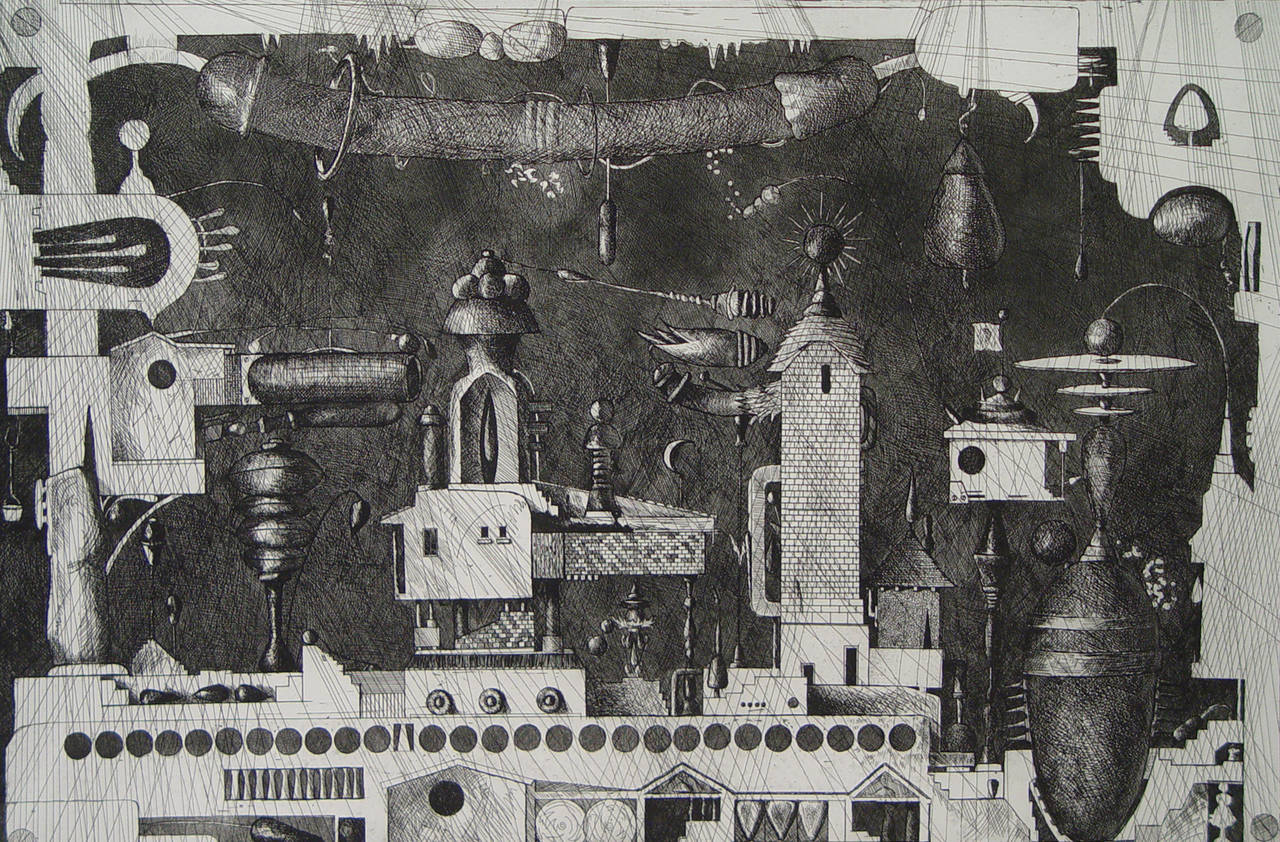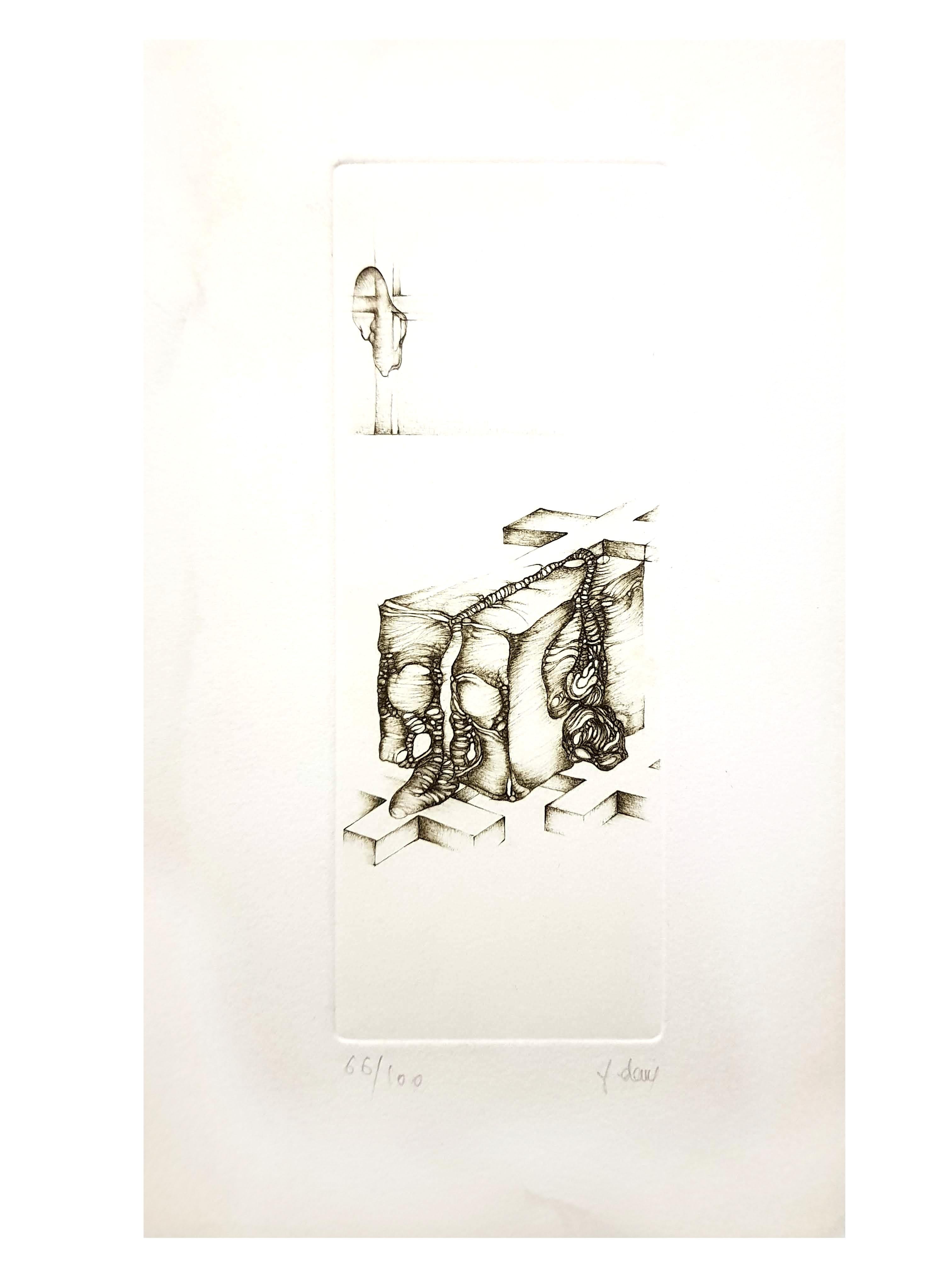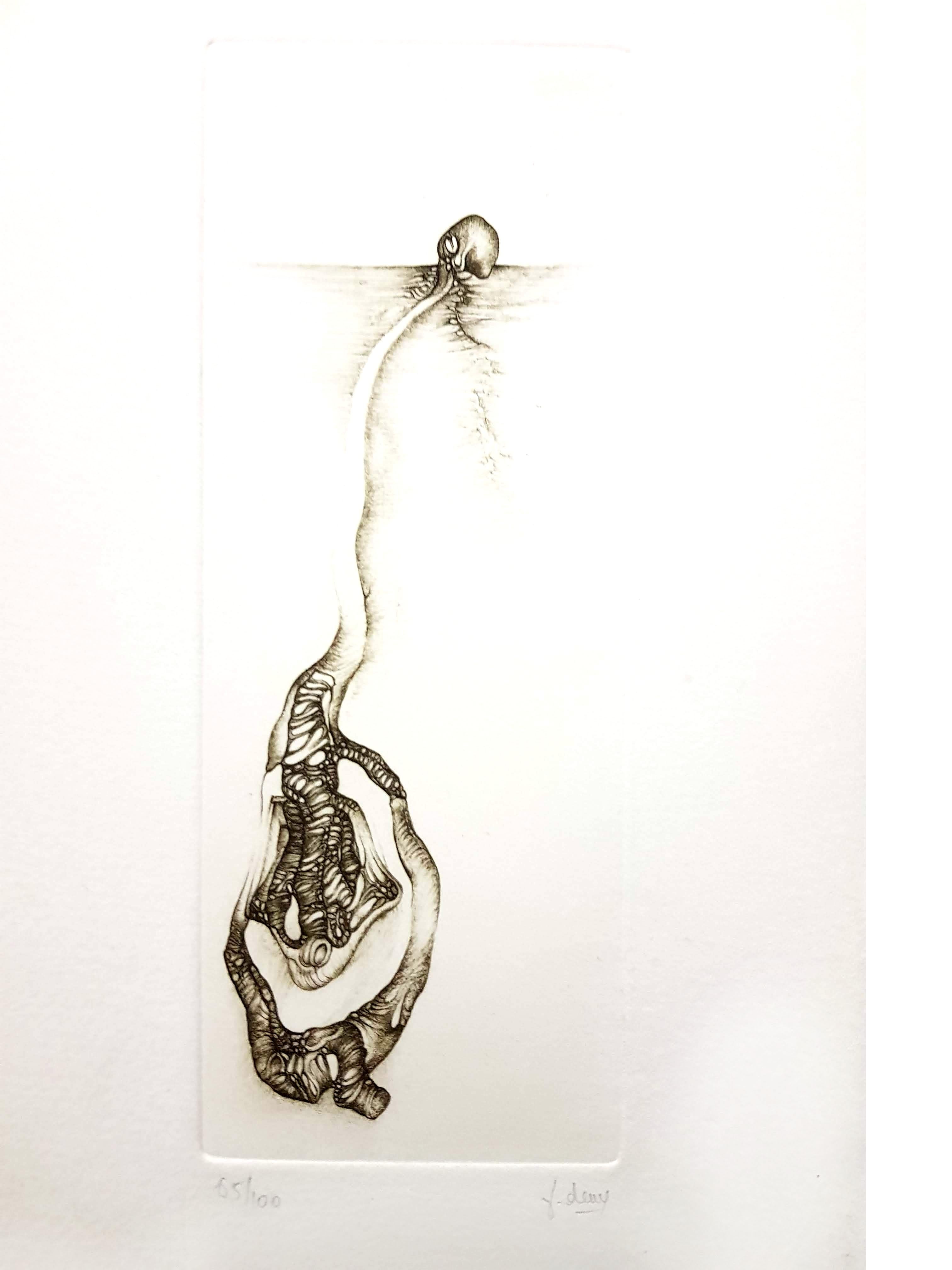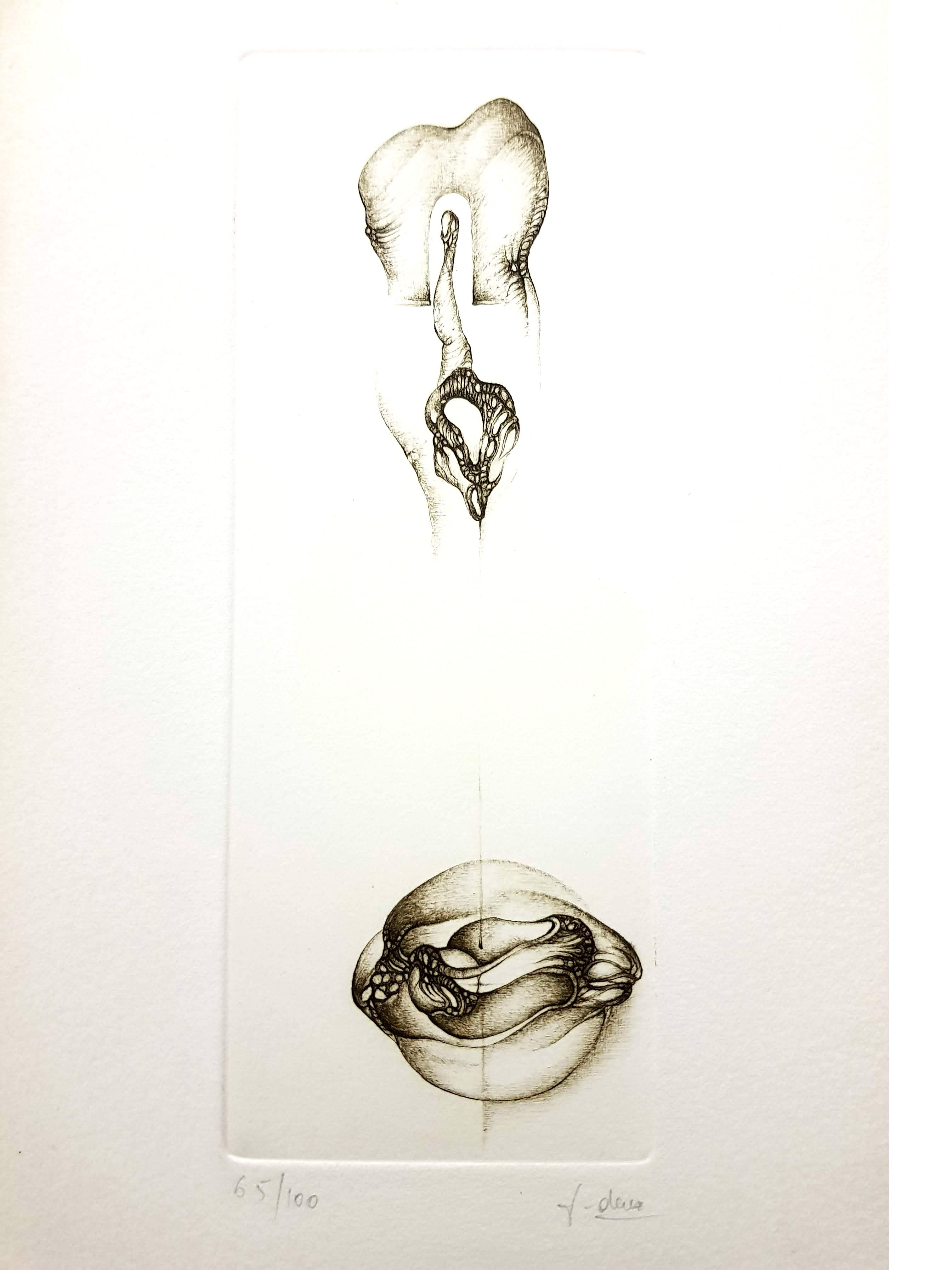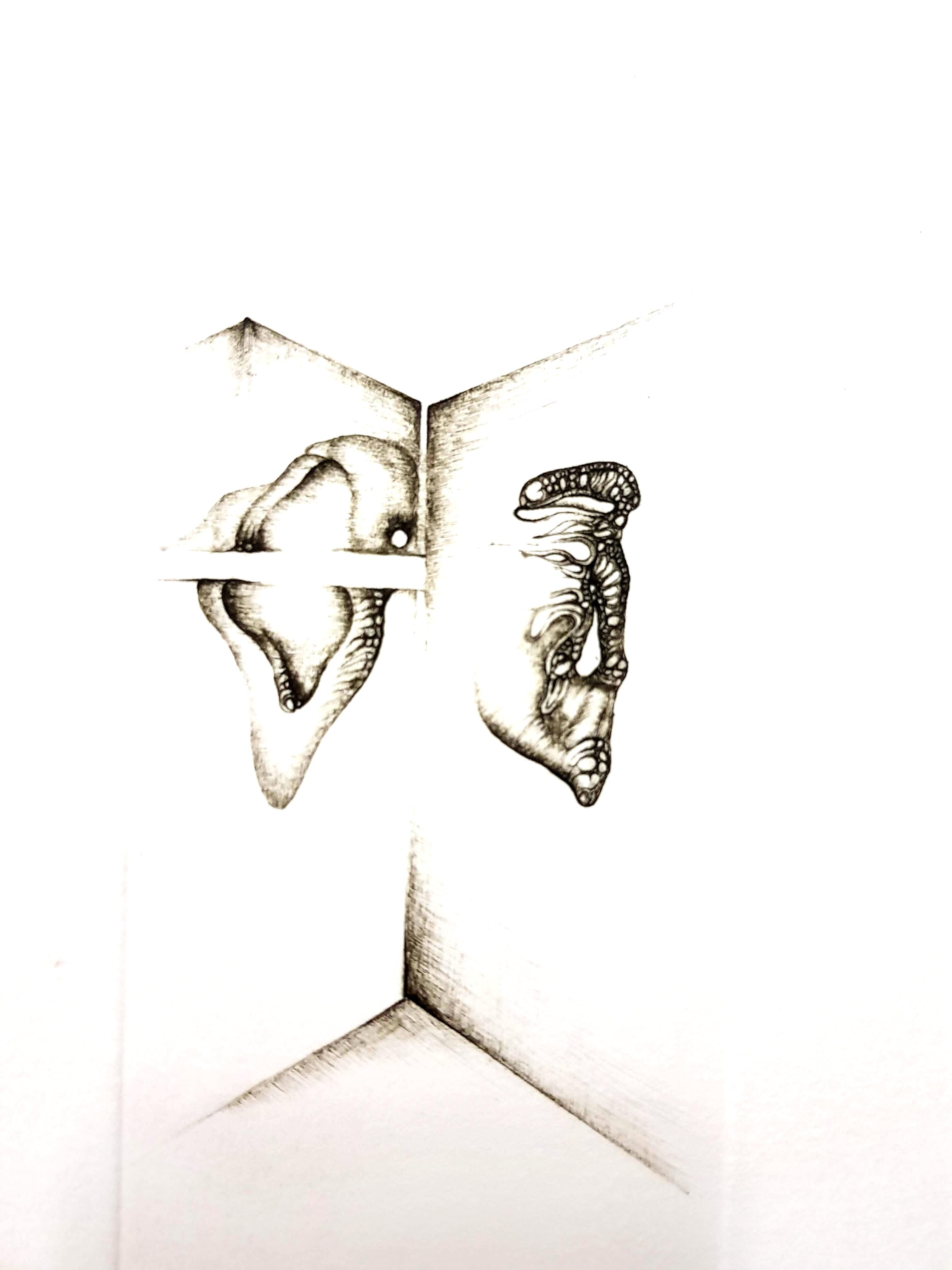Items Similar to Whistle
Want more images or videos?
Request additional images or videos from the seller
1 of 2
Valton TylerWhistle1971
1971
About the Item
In The New York Times Arts in America column, Edward M. Gomez writes of Valton Tyler, "visionary seems the right word for describing his vivid, unusual and technically refined paintings, prints and drawings, whose style defies convenient labels. Abstract, surreal, cartoonish, sci-fi fantastic, metaphysical, apocalyptic-Baroque - all of these fit but also fall short of fully describing his art." (The Living Arts, June 13, 2000, p. B2)
Valton Tyler was born in 1944 in Texas, where "the industrial world of oil refineries made a long-lasting impression on Valton as a very young child living in Texas City. He was three years old when the terrible explosion occurred there and can remember the terrifying confusion and 'the beautiful red sky and objects flying everywhere in the air.'" (Reynolds, p. 25) While growing up in Texas City, Valton's father worked in auto repair, and was known for his skill in mixing colors for paint jobs. After leaving Texas City, Valton made his way to Dallas, where he briefly enrolled at the Dallas Art Institute, but found it to be too social and commercial for his taste. After Valton's work was introduced to Donald Vogel (founder of Valley House Gallery), "Vogel arranged for Tyler to use the printmaking facilities in the art department of the Southern Methodist University in Dallas, where the young artist essentially taught himself several demanding printmaking techniques. 'It was remarkable,' Vogel says. 'Not only did he learn complicated etching methods, but he was able to express himself powerfully in whatever medium he explored.' Vogel became the publisher of Tyler's prints. Among them, the artist made editions of some 50 different images whose sometimes stringy abstract forms and more solid, architecturally arresting elements became the precursors of his later, mature style." (Gomez, Raw Vision #35, p. 36)
“Whistle” is plate number 54, and is reproduced in "The First Fifty Prints: Valton Tyler" with text by Rebecca Reynolds, published for Valley House Gallery by Southern Methodist University Press, Dallas, Texas, 1972.
In "The First Fifty Prints," Reynolds wrote, “With this last plate, Valton returns to the smaller designs he began with and to the humorous flavor he feels all of his work is based on. He has beautifully combined many of the lessons he feels he has learned in the past works: setting forms in their own landscape; attaining the subtle but rich tonal values through line etching; creating a movement across the surfaces and in the air with patterns of floating particles; developing forms with heavier bases, but retaining a lightness by contrasting these with this characteristic spindly forms which rise gracefully into the air. What Valton derives the greatest personal satisfaction from in this plate is the manner in which he feels he has based his design on the depiction of sound. For the artist, the design embodies the word, the instrument, and the sound of the title, “Whistle.” The beauty of this final plate is enhanced by the nostalgic inclusion of elements such as the flag, which was his early signature, and the flower. He leaves us with the beauty of his bitter-sweet empathy with design and form." (Reynolds, p. 144)
Media: line etching on BFK Rives rag paper
Paper size: 17 x 14 inches
Edition: 5 Artists Proofs Imp. 50 Signed Prints Imp.
Bibliography:
Edward M. Gomez, "Futuristic Forms Frolic Under Eerie Texan Skies," The New York Times, June 13, 2000, page B2.
Edward M. Gomez, "Valton Tyler's Techno-Organic Landscapes," Raw Vision 35, Summer 2001, pages 34-39.
Rebecca Reynolds, "The First Fifty Prints: Valton Tyler," published for Valley House Gallery by Southern Methodist University Press, Dallas, Texas, 1972.
This print is unframed. The price does not include a frame.
- Creator:Valton Tyler (1944, American)
- Creation Year:1971
- Dimensions:Height: 12 in (30.48 cm)Width: 9.5 in (24.13 cm)
- Medium:
- Movement & Style:
- Period:
- Condition:
- Gallery Location:Dallas, TX
- Reference Number:
About the Seller
5.0
Recognized Seller
These prestigious sellers are industry leaders and represent the highest echelon for item quality and design.
Established in 1954
1stDibs seller since 2013
151 sales on 1stDibs
Typical response time: Several days
Associations
Art Dealers Association of America
- ShippingRetrieving quote...Ships From: Dallas, TX
- Return PolicyA return for this item may be initiated within 2 days of delivery.
More From This SellerView All
- Night ShiftBy Valton TylerLocated in Dallas, TXIn The New York Times Arts in America column, Edward M. Gomez wrote of Valton Tyler, "visionary seems the right word for describing his vivid, unusual and technically refined paintin...Category
1970s Surrealist Still-life Prints
MaterialsRag Paper, Etching, Aquatint
- Snowman with Black HatBy Gail NorfleetLocated in Dallas, TXGail Norfleet earned her BFA at The University of Texas at Austin, and her MFA at Southern Methodist University in Dallas. Among others, she has had solo exhibitions in Dallas at The...Category
21st Century and Contemporary Contemporary Still-life Prints
MaterialsMonotype
- Appearing and DisappearingBy Gail NorfleetLocated in Dallas, TXGail Norfleet earned her BFA at The University of Texas at Austin, and her MFA at Southern Methodist University in Dallas. Among others, she has had solo exhibitions in Dallas at The...Category
21st Century and Contemporary Contemporary Still-life Prints
MaterialsMonotype
- A Sculpture Framed by a PrintBy Valton TylerLocated in Dallas, TXIn The New York Times Arts in America column, Edward M. Gomez writes of Valton Tyler, "visionary seems the right word for describing his vivid, unusual and technically refined painti...Category
Late 20th Century Surrealist Prints and Multiples
MaterialsRag Paper, Etching, Aquatint
- Music BoxBy Valton TylerLocated in Dallas, TXIn The New York Times Arts in America column, Edward M. Gomez wrote of Valton Tyler, "visionary seems the right word for describing his vivid, unusual and technically refined paintin...Category
1970s Surrealist Still-life Prints
MaterialsRag Paper, Etching, Aquatint
- Pillow MachineBy Valton TylerLocated in Dallas, TXIn The New York Times Arts in America column, Edward M. Gomez wrote of Valton Tyler, "visionary seems the right word for describing his vivid, unusual and technically refined paintin...Category
1960s Surrealist Abstract Prints
MaterialsRag Paper, Etching, Aquatint
You May Also Like
- Fred Deux - Grey Surrealism IV - Signed Original EtchingBy Fred DeuxLocated in Collonge Bellerive, Geneve, CHFred Deux - Grey IV - Signed Original Etching Signed and Numbered Edition of 100 Dimensions: 24 x 14 cm Fred Deux Fred Deux, illustrator, oral poet, writer, and, under the pseudonym Jean Douassot, author of a cult book, La Gana, was a singular artist who cannot be categorised in terms of art fashions and trends. This autodidact, born in the basement of a large house in Boulogne-Billancourt to a working-class family, constantly had to overcome, as he would say. “He had to overcome”: overcome the basement walls to access the life which called him and burnt inside him. Overcome the barriers between the arts, moving from drawing to the written word, and from the page to the tape recorder, in the face of which he recounted stories to himself in a sort of endless reverie, constantly exploring the unknown in him. Overcoming and being overcome: gradually immersing himself in drawing, so that it was life itself which overcame him and surrendered to him. Timeline 1924 Born in Boulogne-Billancourt, Paris. The Deux family lived in the basement of a building close to the Seine that was often flooded. These living conditions formed the biographical core around in which the artist would develop his work as a future writer and artist. 1942 Deux worked in a factory as an electrician and night guard. 1943 Deux becomes part of the FTP group to resist against the factory. And then joined the Maquis du Doubs. 1945 At the liberation, Deux joined the Moroccan Goumier, and took part of the campaigns of Vosges, Alsace and Germany. 1947 Returned to France. Installation in Marseille. Worked in an important library that belonged to the family of his wife. 1948 Discovered Breton, Bataille, Cendrars, Peret, Sade... and founded the sub-group of Surrealists in Marseille and formed a link with the literary magazine of Marseille, Cahiers du Sud Encounters the works of Paul Klee. He begins creating his first stains with paint for bicycle and impressions (fabric and ink). At the same time, he begins to take notes for what would become "Les Rats", first version of "La Gana". 1951 Meets Cecile Reims...Category
1970s Surrealist Still-life Prints
MaterialsEtching
- Fred Deux - Grey Surrealism III - Signed Original EtchingBy Fred DeuxLocated in Collonge Bellerive, Geneve, CHFred Deux - Grey III - Signed Original Etching Signed and Numbered Edition of 100 Dimensions: 24 x 14 cm Fred Deux Fred Deux, illustrator, oral poet, writer, and, under the pseudonym Jean Douassot, author of a cult book, La Gana, was a singular artist who cannot be categorised in terms of art fashions and trends. This autodidact, born in the basement of a large house in Boulogne-Billancourt to a working-class family, constantly had to overcome, as he would say. “He had to overcome”: overcome the basement walls to access the life which called him and burnt inside him. Overcome the barriers between the arts, moving from drawing to the written word, and from the page to the tape recorder, in the face of which he recounted stories to himself in a sort of endless reverie, constantly exploring the unknown in him. Overcoming and being overcome: gradually immersing himself in drawing, so that it was life itself which overcame him and surrendered to him. Timeline 1924 Born in Boulogne-Billancourt, Paris. The Deux family lived in the basement of a building close to the Seine that was often flooded. These living conditions formed the biographical core around in which the artist would develop his work as a future writer and artist. 1942 Deux worked in a factory as an electrician and night guard. 1943 Deux becomes part of the FTP group to resist against the factory. And then joined the Maquis du Doubs. 1945 At the liberation, Deux joined the Moroccan Goumier, and took part of the campaigns of Vosges, Alsace and Germany. 1947 Returned to France. Installation in Marseille. Worked in an important library that belonged to the family of his wife. 1948 Discovered Breton, Bataille, Cendrars, Peret, Sade... and founded the sub-group of Surrealists in Marseille and formed a link with the literary magazine of Marseille, Cahiers du Sud Encounters the works of Paul Klee. He begins creating his first stains with paint for bicycle and impressions (fabric and ink). At the same time, he begins to take notes for what would become "Les Rats", first version of "La Gana". 1951 Meets Cecile Reims...Category
1970s Surrealist Still-life Prints
MaterialsEtching
- Fred Deux - Grey Surrealism II - Signed Original EtchingBy Fred DeuxLocated in Collonge Bellerive, Geneve, CHFred Deux - Grey I - Signed Original Etching Signed and Numbered Edition of 100 Dimensions: 24 x 14 cm Fred Deux Fred Deux, illustrator, oral poet, writer, and, under the pseudonym Jean Douassot, author of a cult book, La Gana, was a singular artist who cannot be categorised in terms of art fashions and trends. This autodidact, born in the basement of a large house in Boulogne-Billancourt to a working-class family, constantly had to overcome, as he would say. “He had to overcome”: overcome the basement walls to access the life which called him and burnt inside him. Overcome the barriers between the arts, moving from drawing to the written word, and from the page to the tape recorder, in the face of which he recounted stories to himself in a sort of endless reverie, constantly exploring the unknown in him. Overcoming and being overcome: gradually immersing himself in drawing, so that it was life itself which overcame him and surrendered to him. Timeline 1924 Born in Boulogne-Billancourt, Paris. The Deux family lived in the basement of a building close to the Seine that was often flooded. These living conditions formed the biographical core around in which the artist would develop his work as a future writer and artist. 1942 Deux worked in a factory as an electrician and night guard. 1943 Deux becomes part of the FTP group to resist against the factory. And then joined the Maquis du Doubs. 1945 At the liberation, Deux joined the Moroccan Goumier, and took part of the campaigns of Vosges, Alsace and Germany. 1947 Returned to France. Installation in Marseille. Worked in an important library that belonged to the family of his wife. 1948 Discovered Breton, Bataille, Cendrars, Peret, Sade... and founded the sub-group of Surrealists in Marseille and formed a link with the literary magazine of Marseille, Cahiers du Sud Encounters the works of Paul Klee. He begins creating his first stains with paint for bicycle and impressions (fabric and ink). At the same time, he begins to take notes for what would become "Les Rats", first version of "La Gana". 1951 Meets Cecile Reims...Category
1970s Surrealist Still-life Prints
MaterialsEtching
- Fred Deux - Grey Surrealism VI - Signed Original EtchingBy Fred DeuxLocated in Collonge Bellerive, Geneve, CHFred Deux - Grey VI - Signed Original Etching Signed and Numbered Edition of 100 Dimensions: 24 x 14 cm Fred Deux Fred Deux, illustrator, oral poet, writer, and, under the pseudon...Category
1970s Surrealist Still-life Prints
MaterialsEtching
- Fred Deux - Grey Surrealism I - Signed Original EtchingBy Fred DeuxLocated in Collonge Bellerive, Geneve, CHFred Deux - Grey I - Signed Original Etching Signed and Numbered Edition of 100 Dimensions: 24 x 14 cm Fred Deux Fred Deux, illustrator, oral poet, writer, and, under the pseudony...Category
1970s Surrealist Still-life Prints
MaterialsEtching
- Fred Deux - Grey Surrealism V - Signed Original EtchingBy Fred DeuxLocated in Collonge Bellerive, Geneve, CHFred Deux - Grey V - Signed Original Etching Signed and Numbered Edition of 100 Dimensions: 24 x 14 cm Fred Deux Fred Deux, illustrator, oral poet, writer, and, under the pseudonym Jean Douassot, author of a cult book, La Gana, was a singular artist who cannot be categorised in terms of art fashions and trends. This autodidact, born in the basement of a large house in Boulogne-Billancourt to a working-class family, constantly had to overcome, as he would say. “He had to overcome”: overcome the basement walls to access the life which called him and burnt inside him. Overcome the barriers between the arts, moving from drawing to the written word, and from the page to the tape recorder, in the face of which he recounted stories to himself in a sort of endless reverie, constantly exploring the unknown in him. Overcoming and being overcome: gradually immersing himself in drawing, so that it was life itself which overcame him and surrendered to him. Timeline 1924 Born in Boulogne-Billancourt, Paris. The Deux family lived in the basement of a building close to the Seine that was often flooded. These living conditions formed the biographical core around in which the artist would develop his work as a future writer and artist. 1942 Deux worked in a factory as an electrician and night guard. 1943 Deux becomes part of the FTP group to resist against the factory. And then joined the Maquis du Doubs. 1945 At the liberation, Deux joined the Moroccan Goumier, and took part of the campaigns of Vosges, Alsace and Germany. 1947 Returned to France. Installation in Marseille. Worked in an important library that belonged to the family of his wife. 1948 Discovered Breton, Bataille, Cendrars, Peret, Sade... and founded the sub-group of Surrealists in Marseille and formed a link with the literary magazine of Marseille, Cahiers du Sud Encounters the works of Paul Klee. He begins creating his first stains with paint for bicycle and impressions (fabric and ink). At the same time, he begins to take notes for what would become "Les Rats", first version of "La Gana". 1951 Meets Cecile Reims...Category
1970s Surrealist Still-life Prints
MaterialsEtching
Recently Viewed
View AllMore Ways To Browse
American Flag Object
Framed Flower Etching
Industrial Explosion Proof
Bitter Vintage
Us Flag Vintage
Us Vintage Flag
Vintage Us Flags
Southern Flag
Fall Leaves Vintage
Vintage Fall Leaves
Retro Us Flag
Etchings By Whistler
Reynolds Etching
Old Vintage Flag
Retro Sci Fi Painting
Retro Futuristic Paintings
50 American Flag
Retro Futuristic Elements
